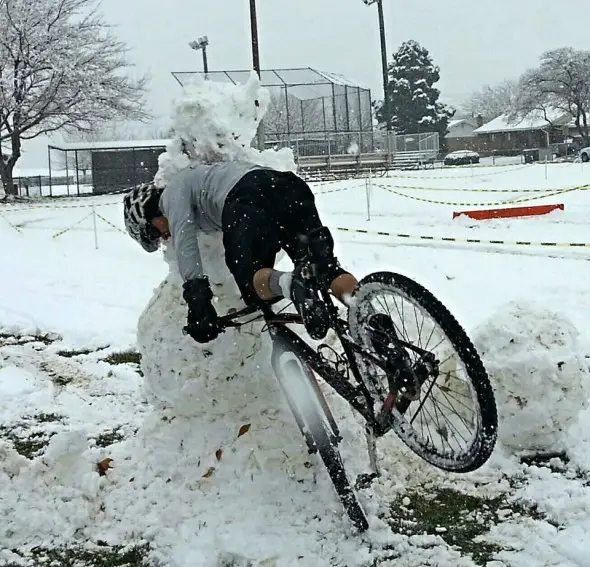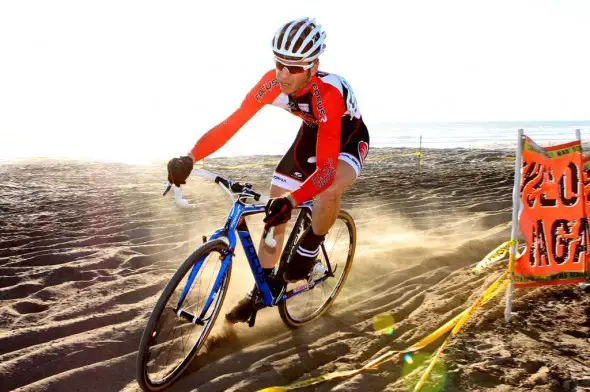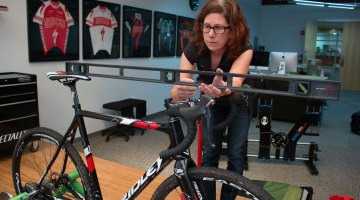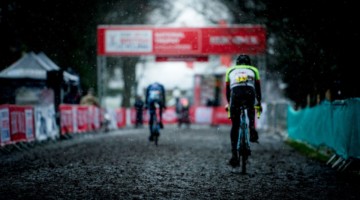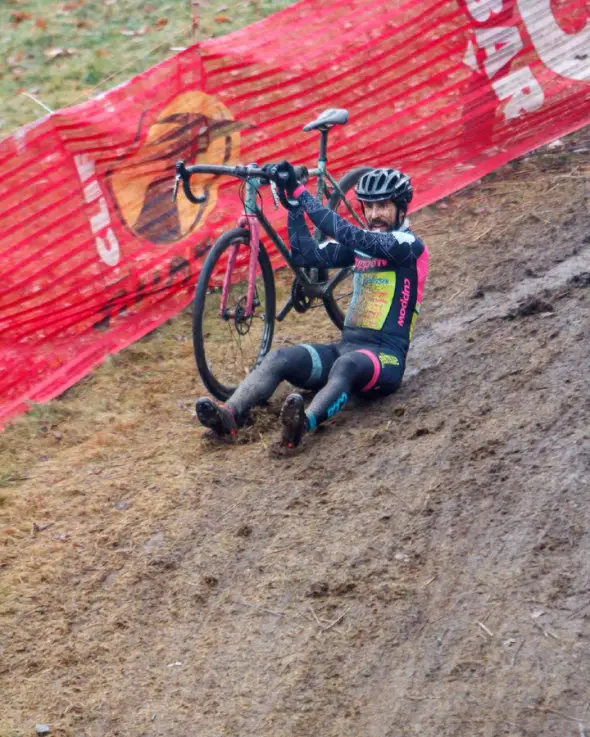
At Baystate Cyclocross Day 2 2013, riders were able to find their inner child in the rough weather. © Russ Campbell
Cyclocross is essentially the Post Office of the cycling world, and just as is written on the New York City USPS building, we have our own motto: “Neither snow nor rain nor heat nor gloom of night prevents these ′crossers from the sloppy completion of their appointed laps.”
No matter the weather, the cyclocross race will likely go on. Last year during the UCI Baystate Cyclocross weekend, every corner was a sheet of ice and the snow churned the course into a mud pile, effectively turning one everyday descent into a literal slip-n-slide. In Austin, TX, where the 2015 Nationals will be held, it is not unusual for the annual Six Shooter race to hit temperatures of 103°F. The Midnight Ride of Cyclocross, the kickoff event of New England’s Holy Week, is aptly named as half the races take place at night under stadium lights. In 2013, Nationals was freezing, and the Masters Worlds course needed to be drained to make it ride-able, but still, the races happened.
Race promoters might delay the race or even cancel it in the event of large snowfalls, but that doesn’t stop other promoters from sticking to the original plan even if it means the first riders of the day are wading through four feet of snow. Some might even be sadistic enough to cross their fingers for that kind of weather so they can bring all of their nephews and nieces along to throw snowballs at anyone foolish enough to actually race on the course.
Ask most pro racers which kind of conditions they prefer and they will tell you they love the mud. Cyclocross culture even has its own names for different types of mud. There’s the slippery grease-mud, the traction-aiding peanut-butter-mud, and there’s even cement-mud, but that last one could also be called the frozen ground. These all come with the timing of the rainfall and with different temperatures.
Moral of the story? Be prepared for the worst. Riding cross-eyed with your legs full of pain is tough enough—you don’t want to be forced out of your race from being too cold. If it’s raining, an extra set of clothes for the pre-ride and warm-up is highly recommended. A waterproof jacket and pants is also helpful in keeping you warm until you head to the start line. Don’t take off those layers until you have to. Most elite racers roll to the start line bundled up like ice fishermen at a slumber party.
Don’t forget to bring a warm set of clothes to change into after the race. You’ll want to watch others suffer through the same conditions, and a nice warm jacket will let you enjoy a nice cold beer and some food while you watch the show.
In the wet and cold, consider using embrocation to keep your legs warm instead of legwarmers that will soak through in seconds—we have a full set of embro reviews here—but apply carefully. The full effect of embrocation usually takes 20 minutes to kick in, so the slight tingle of heat you initially feel will fire up, especially when wet. Don’t speed up the process by putting embrocation on before your chamois cream, though. It won’t take 20 minutes for you to regret that mistake. Also remember that embrocation is not a substitute for a pre-race warm up, and assuming that your legs are good to go while you’ve been waiting in your warm car is a recipe for pulling a muscle.
In extreme conditions like the 2013 USAC Cyclocross National Championships, plain water by itself couldn’t be used to clean bikes because it would ice up. If you’re committed to racing in those types of conditions, you get a big pat on the back, but you’ll also need to incorporate some type of antifreeze to keep the gears turning.
Cyclocross in any weather requires a lot of spare clothes and a dedication to maintaining your bike: It doesn’t have to be super expensive, but it does take some serious forethought and planning.
Get schooled in cyclocross with our Cyclocross Academy class list here, and make sure you’re subscribed to Cyclocross Magazine, your guide for getting into the sport, and upping your ’cross knowledge. Not subscribed yet? For the newbies, our Issue 21 has a great feature on buying your first cyclocross bike, and Issue 22 has a story on how to get into racing and what to expect at your first race.













